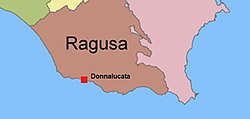
Sicily is an island in the central Mediterranean Sea, south of the Italian Peninsula in continental Europe and is one of the 20 regions of Italy. With 4.8 million inhabitants, including 1.3 million in and around the capital city of Palermo, it is the most populous island in the Mediterranean Sea. It is named after the Sicels, who inhabited the eastern part of the island during the Iron Age. Sicily has a rich and unique culture in arts, music, literature, cuisine, and architecture. Its most prominent landmark is Mount Etna, the tallest active volcano in Europe, and one of the most active in the world, currently 3,357 m (11,014 ft) high. The island has a typical Mediterranean climate. It is separated from Calabria by the Strait of Messina. It is one of the five Italian autonomous regions and is generally considered part of Southern Italy.
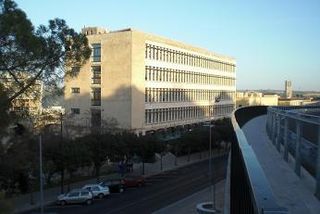
The province of Ragusa was a province in the autonomous region of Sicily, Italy, located in the southeast of the island. Following the abolition of the Sicilian provinces, it was replaced in 2015 by the free municipal consortium of Ragusa. Its capital is the city of Ragusa, Sicily, which is the most southerly provincial capital in Italy.
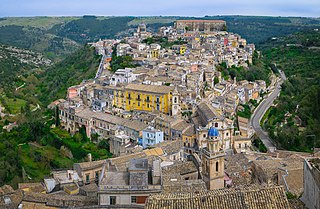
Ragusa is a city and comune in southern Italy. It is the capital of the province of Ragusa, on the island of Sicily, with 73,288 inhabitants in 2016. It is built on a wide limestone hill between two deep valleys, Cava San Leonardo and Cava Santa Domenica. Together with seven other cities in the Val di Noto, it is part of a UNESCO World Heritage Site.

The province of Caltanissetta is a province in the southern part of Sicily, Italy. Following the suppression of the Sicilian provinces, it was replaced in 2015 by the free municipal consortium of Caltanissetta. The province contains 22 comuni. Its coat of arms is a red crest and two green leaf stems on top with a laurel leaf on the right and a crown in the middle. The River Salso is the main river of the province; it is 122 kilometres (76 mi) long and originates in the province of Palermo, and it flows into the Mediterranean in this province at the end of the Gulf of Gela.

Val di Noto is a historical and geographical area encompassing the south-eastern third of Sicily; it is dominated by the limestone Hyblaean plateau. Historically, it was one of the three valli of Sicily.

Scicli is a town and municipality in the Province of Ragusa in the south east of Sicily, southern Italy. It is 25 kilometres (16 mi) from Ragusa, and 188 kilometres (117 mi) from Palermo, and has a population (2017) of 27,051. Alongside seven other cities in the Val di Noto, it has been listed as one of UNESCO's World Heritage Sites.

Salvatore Licitra was an Italian operatic tenor.

Vittoria is a town and comune in the province of Ragusa, Sicily, southern Italy. With its 64,212 inhabitants, Vittoria is the second most populated municipality of the province after Ragusa.

Santa Croce Camerina is a town and comune in the province of Ragusa, Sicily, in southern Italy. As of 2017 its population was of 10,973.
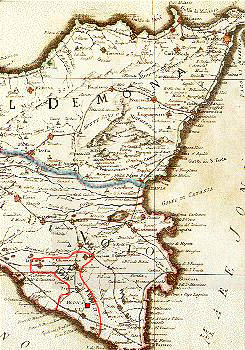
The County of Modica was a feudal territory within the Kingdom of Sicily from 1296 to 1812. Its capital was Modica, on the southern tip of the island, although the cities of Ragusa and Scicli housed some government offices for a period. Today it is perpetuated only as a title held by the head of the House of Alba, Carlos Fitz-James Stuart, 19th Duke of Alba.

The 1693 Sicily earthquake struck parts of southern Italy near Sicily, then a territory part of the Crown of Aragon by the Kings of Spain Calabria, and Malta on 11 January at around 21:00 local time. This earthquake was preceded by a damaging foreshock on 9 January. The main quake had an estimated magnitude of 7.4 on the moment magnitude scale, the most powerful in Italian recorded history, and a maximum intensity of XI (Extreme) on the Mercalli intensity scale, destroying at least 70 towns and cities, seriously affecting an area of 5,600 square kilometres (2,200 sq mi) and causing the death of about 60,000 people.
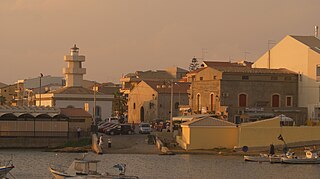
Scoglitti is a fishing village and hamlet of Vittoria, a municipality in the Province of Ragusa, Sicily, Italy. In 2011 it had a population of 4,175.

Marina di Ragusa, also known as Mazzarelli, is a southern Italian village and hamlet (frazione) of Ragusa, a municipality seat of the homonym province, Sicily. In 2011 it had a population of 3,468, which during the summer rises to more than 60,000.
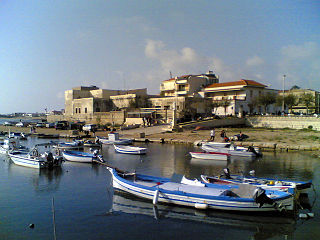
Punta Secca, locally nicknamed ’A Sicca, is a small southern Italian fishing village and hamlet (frazione) of Santa Croce Camerina, a municipality in the Province of Ragusa, Sicily. In 2011 it had a population of 226.

Kaukana, also spelled Caucana, is a hamlet (frazione) of Santa Croce Camerina, a municipality in the Province of Ragusa, Sicily, Italy. It is located a few hundred metres from Punta Secca and a few km from Marina di Ragusa.

The Inspector Montalbano television series are Italian police procedural stories. Based on Andrea Camilleri's detective novels, they are located in the imaginary town of Vigàta, Sicily, which is based on Camilleri's native Porto Empedocle. The series protagonist, Salvo Montalbano, is the police chief, or commissario.
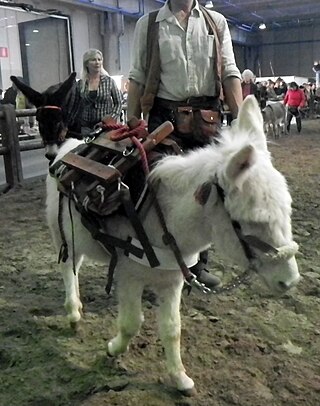
The Ragusano is a breed of donkey from the Mediterranean island of Sicily. It is associated particularly with the comuni of Modica, Ragusa, Santa Croce Camerina and Scicli, all in the Province of Ragusa in southern Sicily. It is one of the eight autochthonous donkey breeds of limited distribution recognised by the Ministero delle Politiche Agricole Alimentari e Forestali, the Italian ministry of agriculture and forestry. The Ragusano was listed as "endangered" by the FAO in 2007.
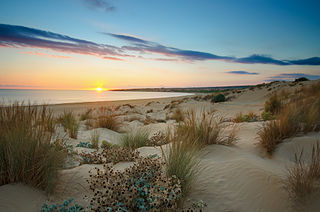
Sampieri is a southern Italian fishing village and hamlet (frazione) of Scicli, a municipality in the Province of Ragusa, Sicily. In 2011 it had a population of 669.
Acqua Santa Maria is the main brand of the company Sicil Acque Minerali, Si.A.M. srl that is a company with registered office in Ragusa and operational headquarters Modica in Sicily, which since 1992 manages the extraction and bottling of mineral waters.

Cava d'Aliga is a southern Italian village and marine hamlet (frazione) of Scicli, a municipality part of the Province of Ragusa, Sicily.

